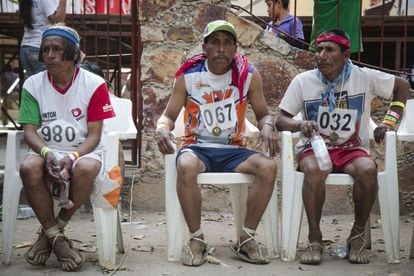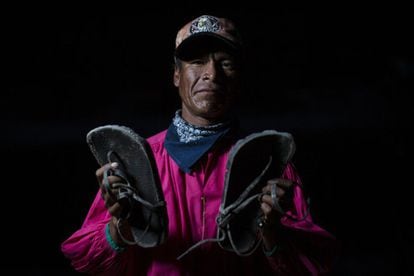Tarahumara runners return to Mexico’s Copper Canyon
A year after drug violence prompted cancellation, ultramarathon attracts 600 competitors


Their feet barely touching the ground, members of the Tarahumara tribe were once again competing in the 80-kilometer Caballo Blanco ultramarathon at Copper Canyon in northern Mexico's Chihuahua state on the first Sunday of March. Running in handcrafted huarache sandals made from used tires and wearing everyday clothes, the indigenous athletes take no dietary supplements and their prize is a few sacks of corn and black beans, along with the honor of upholding an ancient tradition.
Last year’s race was cancelled at the last moment over fears for contestants’ safety amid an escalating turf war between rival drug cartels. Now, Urique, the community where the race begins, is quiet, and instead of gunshots the silence of the morning is pierced only by the sound of roosters crowing. But a year ago, gunmen paid by drug lord Joaquín El Chapo Guzmán were fighting with the La Línea cartel for control of this vast ravine, which is deeper than the Grand Canyon. “In the end, everybody left,” one Urique resident says. The reason peace has returned a year later is because El Chapo’s men won.

Copper Canyon is located in Mexico’s Sierra Madre Occidental, a mountain range that runs through Chihuahua and Sinaloa. The steep hills and deep valleys make it difficult to access: conditions that make it the perfect enclave for growing and producing marijuana and opium. The Tarahumara Indians have lived here for centuries, keeping first Spanish conquistadores and then modern development at bay. But this remote region is also one the poorest and most neglected areas in Mexico, meaning that outlaws and drug traffickers are usually left alone. A century ago, revolutionary leader Pancho Villa made the area his base.
US athlete Micah True founded the Caballo Blanco race in 2003 after living in the canyon for several years, during which time he learned the customs of the Tarahumara people. Christopher McDougall told True’s story in his best-seller, Born to Run, sparking global interest in Tarahumara culture and a running technique that consists of touching the ground as lightly as possible. “This is Mecca for any runner,” says Patrick Muldowney, who has come to Urique for the first time to take part in the race.

There are no professional runners or Kenyan champions at the starting line in the square in Urique at 6am. Ninety-five percent of the 600 participants are Tarahumara and the rest are amateur runners who have come to learn from the locals and their handmade sandals. “I hurt myself a lot less since I’ve been using sandals. That’s the point. How long has it been since humans stopped walking barefoot and using shoes to run?” asks Freddy Koster, a 54-year-old Swiss lifeguard who has come to Mexico just to participate in this race.
It takes a Tarahumara runner between six and seven hours to finish the complicated dirt track route, which includes steep slopes and is pitted with rocks and brooks. One of the foods that helps them endure the heat and avoid dehydration is pinole, a drink made from roasted corn flour. In the first aid stands along the route, volunteers prepare the drink and offer it to participants as they pass by.

The runners eat nothing special in preparation for the run. Marisela Cuevas has been cooking the dinners local runners consume before the next day’s race for six years. The menu includes a chicken and vegetable broth that includes nixtamal, a maize flour, along with black beans.

For Miguel Villegas, a 33-year-old Tarahumara, the Caballo Blanco weekend is a special occasion. He has walked 10 hours from his home in the tiny community of Batopilas to participate in this race. Last year he won second place and took home a good amount of grain to feed his three children and wife. “If my children want to run when they are older, I will also bring them here.” Villegas is wearing a pink poplin shirt his wife sewed for him by hand. A farmer, leaving his hometown for the race is a special occasion that calls for new huarache sandals that will cost him around $5 to make: “They are expensive, but they last all year.”
The sandals used by the Tarahumara inspired a US entrepreneur to start a store in Seattle that he sells for $100.
Villegas remains calm, breathing easily as he runs. Even after four hours, when other runners begin to show signs of exhaustion, he seems confident. This year he won’t be taking home a prize, but he’s happy to finish the race. Afterwards, he spends the night in Urique, resting before walking back home in the morning. He says he’s glad he met the chabochis (mixed-race people) who encouraged him to keep running and who told him about the world beyond Copper Canyon.
His feet are everything to him and says he cannot imagine any life besides the world of running.
“Do you run where you live?” Villegas asks the outsiders from Mexico City
“Sometimes, when I can,” they answer.
“I couldn’t imagine my life without running every single day,” he says, before heading off.










































